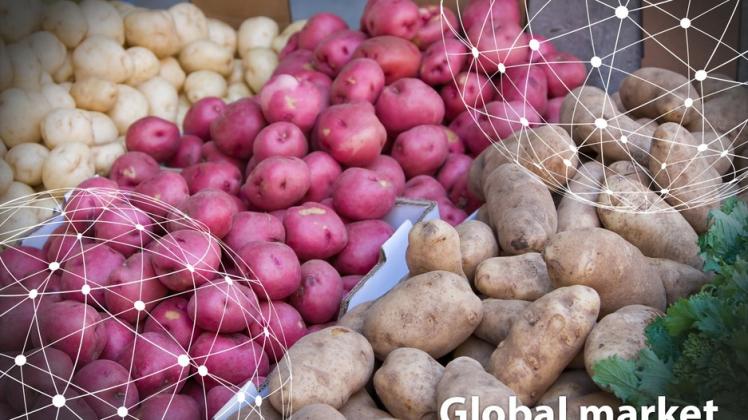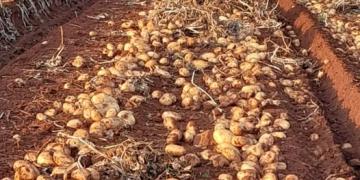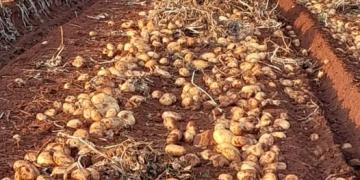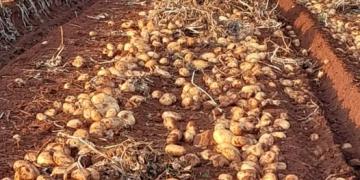Global overview: Potato market situation
European and global potato markets remain under pressure due to marked regional divergence in production trends, weather, and prices.

In Italy, prices have fallen due to increased French supply, while the Netherlands continues to face weak demand and slowing factory production. France is experiencing exceptional production but a deep market imbalance, and Poland’s higher yields have led to falling prices. Switzerland and Austria are enjoying abundant supply and stable demand, although storage and logistical constraints are present. Germany is facing growing quality problems, in addition to constant downward pressure on prices. In Spain, a larger planted area and a late harvest have increased total production, resulting in lower prices and reduced exports.
Outside of Europe, New Zealand growers are reporting mixed planting conditions following an erratic spring, while Australia continues to grapple with a shortage of fresh potatoes after a dry autumn. In North America, yields are good, but prices remain low. South African farmers are facing significant losses as oversupply drives prices below the cost of production. Egypt anticipates a more robust season thanks to improved seed quality and favorable planting conditions, while Pakistan is reporting record production and increased export volumes to key regional markets.
Italy : Prices fall amid French supply pressure. A major potato producer and trader in northern Italy says, "There seems to be a surplus of product in northern Europe. We are in a period of reflection." The Italian market remains stable and calm. Prices, which had been inflated in recent months, have now fallen due to pressure from French production. Currently, Italian producers are receiving between €0.25 and €0.30 per kilogram.
Demand from large retail chains is not yet very high, but orders are expected to increase from November onwards. There are no major fluctuations, and the market remains fairly stable. Italy continues to import potatoes because its production does not meet domestic demand, meaning the Italian market is influenced by the overall European situation. Potatoes with Protected Designation of Origin (PDO) and Protected Geographical Indication (PGI) status are performing better, as they are easily recognizable by consumers and enjoy higher demand. The open market remains stable, with supply slightly exceeding demand, which is typical for this time of year.
According to YouGov data, nearly 90% of Italian households buy potatoes. They purchase them both by weight and in traditional fixed-weight sacks, with little difference between the two options due to considerable overlap. Organic potatoes stand out in this context, as more than 25% of households buy them, a figure uncommon in the fruit and vegetable sector. This percentage has been increasing over the last three years. The frequency of purchases remains constant at around 11 times a year, as does the average expenditure per purchase, which is around €2.60. However, the quantity per purchase has decreased from almost 2 kilograms in the year ending August 2023 to just under 1.8 kilograms in the most recent period.
Netherlands : Little change in the potato market. The potato market is going through a difficult period. “At the moment, prices are barely moving. The main problem, in my opinion, is the planned production shutdowns and reduced activity at factories. This is holding back demand, and it should be the processing industry that signals the market is ready to recover, but that hasn’t happened yet,” says a Dutch potato trader. “Of course, there is a surplus of potatoes on the market, but the main problems now stem from geopolitical tensions and the fact that chip sales in Europe are slower than expected. This certainly doesn’t make things any easier.”
However, another trader is optimistic. “Yes, there are plenty of potatoes in the EU, and the potato chip and processing market isn’t performing as it should, but we also know that factories don’t buy cheap potatoes. Everyone says potato chips are cheap, but that’s not true; they all have expensive contracts. I still remember a saying my old partners taught me: ‘Cheap potatoes run out quickly; expensive ones are always available.’”
Belgium : Potato harvest nearly complete with high yields, but market under pressure. The majority of the potato harvest in Belgium is now complete, with approximately 90% of the potatoes already picked. Overall, good yields and high quality are being reported, although the hot, dry summer has led to some variation in size and dry matter content in some areas, particularly among firm-cooking varieties. The total volume is higher than last year, but the large supply is putting pressure on an already challenging market, especially since not all growers have storage capacity and some lots need to be sold immediately.
There is demand in the export market, but it is limited, partly due to competition from producers in Southern Europe and Poland. This results in low prices and significant variability, depending on quality and packaging. High-quality, ready-to-wash potatoes intended for retail are in high demand and can reach 20 cents per kilo, while standard, unwashed batches typically fetch around 10 cents per kilo.
France : The 2025 potato season faces a significant market imbalance. The 2025 season is at a turning point. France is experiencing an exceptional production of around 8.5 million tons of table potatoes, driven by a 10% increase in cultivated area compared to 2024, reaching 197,000 hectares, and by high yields. However, this surge in potato production, fueled by expectations of strong industrial demand for potato chips, has created a significant short-term imbalance between supply and demand.
Consequently, the market is now clearly segmented. Firm contracts maintain reasonable prices, with deliveries contracted at around €180 per ton, but the open market is collapsing; some lots without contracts are trading at very low prices, between €5 and €15 per ton depending on the case, well below the estimated cost to producers of approximately €150 per ton. This stark contrast explains the financial difficulties of some farms, especially those focused on supplying industrial markets.
Official RNM quotations show relative stability in consumer prices in certain segments (table potatoes, organic potatoes, and quality potatoes), while the industrial segment remains under significant pressure, with few purchases. The presence of residual stocks from 2024 further exacerbates the situation.
Poland : Production increases by 15% thanks to an increase in cultivated area and yields. Potato production in Poland is forecast to reach 6.8 million tons this year, 15% higher than last season. This increase is due to both the expansion of cultivated areas and higher yields per hectare, driven by favorable prices in recent years. Some industry representatives disagree with this forecast, suggesting that production could exceed 7.5 million tons depending on the final development of the crops. According to official data, the average yield is 31.8 tons per hectare, 5% higher than in 2024, when it stood at 30.2 tons per hectare. Despite a dry spring, subsequent rains helped to restore the tubers’ potential.
Demand was slightly lower during the summer months, mainly due to the large availability of locally grown potatoes across the country. However, in recent weeks, a Polish exporter has observed a modest increase in demand, which he sees as a promising sign for the autumn.
Prices have been much lower this season due to record production levels. Alternative crops, such as wheat, have not been particularly attractive this year, encouraging many farmers to plant more potatoes. As a result, there is frustration among farmers, as open market prices have fallen to extremely low levels. Customers increasingly expect single-material and fully recyclable packaging, reflecting a growing awareness of and demand for sustainable solutions.
Switzerland : Potato production 20% higher than last year. In 2025, Swiss farms will harvest more potatoes than in previous years, specifically 20% more than in 2024 and 17% more than the historical average. This increase also has some negative consequences for farmers: prices are falling slightly, quality standards are being enforced more rigorously, and short-term storage capacity has become scarce.
Due to the abundant harvest, there was an unexpected shortage of crates for transporting potatoes during harvesting. Across Europe, the wooden containers known as "paloxes" became a scarce commodity. "Carrots and onions are stored in the same containers and had to be harvested at the same time, so some growers had to delay the potato harvest because they ran out of pallet crates," according to the industry association, Swisspatat.
Austria : Supply is plentiful and market conditions are stable. The table potato harvest in Austria is not yet complete. The main reason for the delay is a shortage of empty crates. However, the situation in the remaining fields is now manageable, and the last harvest is expected to be gathered next week.
The market situation has remained unchanged for several weeks. There is ample supply and steady demand in the domestic food retail sector. However, export opportunities remain limited due to strong price competition from other European producers.
According to LKÖ, producer prices have also remained unchanged. In Lower Austria, producers are paid up to €20 per 100 kilograms of good quality produce, with discounts applied for temporary storage and higher logistics costs. In Upper Austria, the price remains stable between €15 and €20 per 100 kilograms.
Germany : Rising quality problems and continued price pressure. Following the end of storage, packing companies and retailers are continuing to purchase fresh potatoes directly from the fields this week. In several growing regions, there are increasing signs of declining quality in the harvested potatoes. In particular, damage from worms and black spot is becoming more frequent.
At the same time, downward pressure on prices persists across the market, with low-priced products from neighboring regions with surpluses flooding an already saturated market. Even exports are barely profitable under current conditions.
Spain : Larger planted area reduces prices amid late harvest. The potato harvest in northern Spain is in its final stages, about 15 days late due to inclement weather. In Castile and León, the country’s main potato-producing region, the planted area increased by more than 12%, reaching almost 20,000 hectares. While production has not been high this year, the increase in planted area has led to a higher overall yield, resulting in lower prices compared to previous seasons.
This comes at a time of widespread low consumption of fresh potatoes across Europe, where record production has been recorded. The oversupply in many European countries has led to a sharp decline in Spanish exports this season. The price situation has been particularly difficult for producers who expanded their production without contracts or supply programs with traders or distributors.
New Zealand : Inclement weather delays planting in some regions. Planting conditions have been variable this year across New Zealand’s main potato-growing regions. Some areas experienced wet, cool soils, slowing the start of planting, while others benefited from more stable weather that allowed for good crop establishment. Farmers have been working under tight deadlines to complete planting, and some have been affected by late frosts and adverse weather conditions in the south.
A slightly late start in some regions could delay the harvest by one to two weeks. However, if the weather cooperates during November and December, the crops could recover quickly. Volume and size will depend on summer weather conditions.
The first new potatoes, primarily from Northland, Pukekohe, and Waikato, are typically harvested between late October and November to meet early summer and holiday season demand. The main harvest generally runs from February to May, depending on the region and the intended use of the crop: fresh consumption, processing, or seed. Despite initial weather challenges, the crop is establishing itself well, and growers are optimistic about a good season if summer temperatures remain stable with moderate rainfall.
Domestic demand remains stable throughout the year, driven by consumer preference for local products. Key export destinations include Fiji, French Polynesia, New Caledonia, Samoa, and other Pacific island nations, as well as Southeast Asia and Australia for processed potato products. Export volumes fluctuate annually based on domestic supply and regional demand.
Australia : Dry Autumn Leads to Fresh Potato Shortage. Australia has experienced an extremely dry autumn and a late start to winter, with temperatures around three degrees Celsius above normal. These unusual conditions have led to a nationwide potato shortage. The warmer weather affected tuber formation, reducing the number of tubers per plant. These potatoes have been stored in the ground for several months, and quality and volume are not expected to improve until the early spring harvest begins. A normal supply season is unlikely before December.
South Australia, the country’s largest producer of fresh table potatoes, has been the hardest hit region. The Gatton region in Queensland is currently supplying good quality potatoes at fair prices to farmers.
The shortage is affecting only fresh table potatoes and is concentrated in eastern states such as South Australia, Victoria, New South Wales, and Queensland. Supermarkets have adjusted their supply specifications to mitigate the shortage and ensure continued availability.
Strict biosecurity regulations prevent the import of fresh potatoes into Australia, contributing to shortages, although the country continues to import large volumes of frozen potato chips.
North America : Good yields are reported in major producing regions. Despite a slight decrease in planted and harvested U.S. potato acreage in 2025, yields in key regions such as Idaho remain good, with adequate potato size. The fresh potato harvest in regions such as central Minnesota concluded with yields above those of 2024, while Prince Edward Island finished its harvest with average to below-average yields. Other regions, such as Ontario, reported yields above last year’s but still below the five-year average.
Demand for potatoes remains stable and consistent. While last year there was little difference between the stored and new harvests, leading to some overlap, this year the transition has been smoother. Demand for yellow potatoes continues to grow; this segment has more than doubled in the last eight years, increasing in value from approximately €268 million to €564 million.
Potato prices remain relatively low, as the small difference between the previous and current harvests makes it difficult for prices to rise ahead of the new season. However, this situation presents promotional opportunities for retailers.
South Africa : Increased production is causing prices to fall below the cost of production. Farmers currently harvesting potatoes in Limpopo province and Sandveld, Western Cape, are suffering losses of tens of thousands of euros in harvesting and transporting their crop to processors, municipal wholesale markets, and retailers. An additional 2,000 hectares of potatoes were planted between March and April as a precaution against risks such as the July 2024 frosts, which devastated entire fields.
However, the mild winter did not reduce production as expected, resulting in a bountiful potato harvest and a considerable increase in anticipated market volumes over the next month. The scale of the harvest only became apparent at the end of July, when the potato season began in Limpopo. “This potato season is proving very difficult,” says one trader. “In the last two months, not a single potato in South Africa has sold for more than the cost of production.”
Many more potatoes need to be sold to match the revenue of 2023 or 2024, when prices were high. The last time potatoes traded at current price levels was in 2022. Last year’s cumulative prices were more than double current levels. Market sales volumes are higher than in the last two years, but revenue remains low, a situation some describe as deflation.
According to Potatoes SA, sales in the wholesale market of potatoes grown in Limpopo (10 kg bags) increased by 31% during the first 43 weeks of the year compared to last year, with 3.2 million more 10 kg bags sold than the average of the last five years in the region.
“It’s no good transporting all these kilos and not earning a penny,” says one farmer, pointing out that transportation is the biggest cost in the supply chain. Potato production is only now increasing; those grown during the winter have lower yields, further complicating profitability with the current low prices.
At Johannesburg’s municipal market last week, potatoes sold for an average price of less than €0.20 per kilogram. The current wholesale price for a 10 kg sack ranges from €2.40 to €2.70, and a 7 kg sack is around €2.00. A market analyst predicts an increase in supply over the next month, which could prevent prices from exceeding €2.00 per 10 kg.
Quality problems may begin to emerge with the rise in summer temperatures, and low prices could persist until November. The only one who benefits from the current situation, one retailer points out, is the consumer.
Egypt : Improved Seed Quality Boosts Planting. Last season, Egypt’s large potato crop faced weak export demand. Total production exceeded nine million tons, while international demand fell short of expectations, with exports reaching only around 1.3 million tons. At the end of the season, cold storage facilities were still full of potatoes, and prices failed to meet expectations in both the domestic and export markets. Another challenge, according to a major Egyptian potato seed importer, was limited access to good-quality seeds.
In contrast, the upcoming season looks more promising. One exporter stated, "The weather conditions are ideal, and thanks to a sufficient supply of good-quality seeds, planting is going very well."
Exporters are also reporting positive signs in demand. “We are currently seeing high potato prices on the international market and in the home countries of our competitors, which points to strong demand for Egyptian potatoes next season. We anticipate that the next season will be much more dynamic and that the export campaign will be similar to the previous one, which proved very advantageous for Egypt,” stated one exporter.
Pakistan : Exports rise in line with record potato production. Pakistan’s potato production reached approximately 9 to 9.5 million tons in the 2024-25 season, representing a 20% increase over the previous period. Exports have grown in parallel with production, with key destinations including Afghanistan, Sri Lanka, the United Arab Emirates, the Persian Gulf countries, and Central Asian states.
Fresh and chilled potatoes dominate exports, with varieties such as Mozika, Santa, and Ismi, which are graded and packaged according to different standards. The frozen and processed potato segments remain smaller but are expanding, with buyers favoring processing varieties like Lady Rosetta, Hermes, and Asterix, known for their high dry matter and low sugar content.
Currently, export prices average between €170 and €180 per ton. Despite persistent challenges, such as seed quality, post-harvest handling, and freight costs, initiatives in certified seed programs and improvements to packing facilities aim to strengthen the export sector. The outlook points to a stable balance between supply and demand in the coming weeks.
Fuente: Viola van den Hoven-Katsman | FreshPlaza.com




